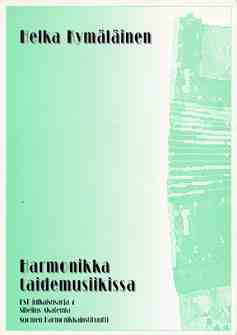
1. Johdanto
2. Konserttiharmonikan Rakenne Paapiirteittain
3. Harmonikanja Harmonikkaohjelmiston Kehitys
4. Harmonikan Instrumentaaliset Erityispiirteet
5. Harmonikan Keskeisimmat kayttotavatja Soittokuviot Seka Niiden
Nuotintaminen (The Main Accordion Techniques and Figures and Their Musical
Notation)
6. Ohjelmistoluettelo Vuosilta 1950-1993 (Catalogue of
Works)
7. Yhteenveto
softcover
18 photographs
265 musical examples
published: 1994
ISBN: 952 9658 30 3
ISSN: 1237 4229
Publisher: Sibelius Akatemia
Solistinen osasto, Esittavan saveltaiteen tutkimusyksikko
PL 86, 00251 Helsinki
Finland
puh. 90-4054- 531
telekopio 90-4054-560
Suomen Harmonikkainstutuutti
39500 Ikaalinen
puh. 933-4586 435
telekopio 933-4512 161
email: minori@sci.fi
Review by Henry Doktorski:
Question: What business is it of mine to write a review of a Finnish book when I have a limited knowledge of the Finnish language?
Answer: 1) This book is chock full of so much great information that even a non-Finnish reader can still get a lot out of it (hey, with 18 photographs and 265 excerpts from the greatest accordion repertoire, you can't go wrong!), and 2) there are English summaries of most of the chapters.
I was thrilled when I received my copy of Harmonikka taidemusiikissa by Helka Kymalainen in the mail. The book is an incredible wealth of knowledge for classical accordionists and composers. I think the 40 page catalogue of hundreds and hundreds of original accordion works is worth the price of the entire book. Pieces are listed chronologically according to
The book is comprehensive and well-researched. The technical description of the anatomy of the accordion (Konserttiharmonikan Rakenne Paapiirteittain) is detailed with illustrations and diagrams of the parts of the instrument, beginning with the individual reeds and continuing through to buttonboard diagrams for bass and treble with corresponding ranges notated on the grand staff, descriptions of melody-bass and standard-bass instruments, stop lists (registers), and notation.
The chapter titled Harmonikanja Harmonikkaohjelmiston Kehitys is a 55 page history of the accordion, with emphasis on its evolution in Finland. Here you will find photos and descriptions of the sheng, J.N. Maazel's Physharmonica (1805), Cyril Demian's accordions! (one from 1829 and one from 1830), Busson's piano accordion (1855), and others. Also included is a photo of a portrait of Louise Reisner and three excerpts from her original accordion piece Theme and Variations (1836), and continuing with sections on Pietro Frosini and Pietro Deiro (who are still very popular composers in Scandinavia), Hugo Herrmann, Mogens Ellegaard, Hugo Noth, Matti Rantanen, etc.
Following comes a section describing exactly what the accordion can do in musical terms with myriad examples from compositions by the greatest composers who have written for the instrument: Ole Schmidt, Vaclav Trojan, Vladimir Zolotaryov, J. Feld, T. Lundquist, Wolfgang Jacobi, A. Krzanowski, A. Nordheim, Leif Kayser, J. Tiensuu, T. Hosokawa, Magnus Lindberg, Kalevi Aho, Isung Yun, G. Wuensch, Alain Abbott, Ernst Krenek, P. Norgard, and many others.
My recommendation? If you don't read Finnish, don't let the language barrier stop you from ordering Harmonikka taidemusiikissa (The Accordion in Classical Music). If you are a classical accordion lover, your library will be incomplete without this beautiful and comprehensive book.
| About The Free-Reed Review |
| Invitation to Contributors / Submission Guidelines |
| Back to The Free-Reed Review Contents
Page |
| Back
to The Classical Free-Reed, Inc. Home Page |